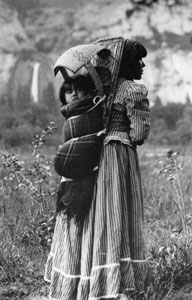
Courtesy of National Park Service (Yosemite National Park/Yosemite Research Library, photo by J.T. Boysen)
As one of the most beloved parks in the National Park System, Yosemite National Park is a popular destination to explore the California wilderness through outdoor activities like camping, hiking, climbing, riding, fishing, birding, and skiing. The park also has many stories to tell about the diverse peoples who played a role in the history of Yosemite and the Sierra Nevada Mountains. Yosemite was the home for some of America’s first peoples for thousands of years before becoming a tourist destination. Seven contemporary American Indian tribes trace their roots to the lands of Yosemite. Today, visitors to the park can explore the natural and cultural history of the Sierra Nevada Mountains at a number of locations. Yosemite Valley Visitor Center provides an orientation to the park, a movie, and brochures to guide visitors through the Yosemite Cemetery, the final resting place of a number of people involved with the park. Next door to the visitor center, the Yosemite Museum offers visitors the opportunity to learn about the cultural history of the park, particularly about the Miwok and Paiute tribes.
The ancestors of today’s tribes arrived in the area roughly 3,000 to 4,000 years ago. Here, they hunted, fished, and gathered plants, moving seasonally throughout the area, but also setting up permanent camps. The Ahwahneechees were another tribe that lived in the parklands, but very few were still alive by the mid-1800s. The Indian Village and Museum behind the Yosemite Museum offers exhibits and cultural demonstrations of Indian life and a short trail through a reconstructed Miwok-Paiute village. An art gallery displays selections from the museum’s art collection. LeConte Memorial Lodge, a National Historic Landmark, seasonally presents environmental programs for adults and children. The lodge was the first park visitor center; today, it is run by the Sierra Club.
Following the discovery of gold in California in the late 1840s, many settlers came west into the area. Hikers in the park can visit a well-preserved silver mine active from 1879 to 1890, called Golden Crown, near Bloody Canyon. The first tourists arrived around 1855. Early visitors included soldiers, artists, writers, and sightseers. Early settlers helped as guides and protected the park, as did soldiers. Between 1891 and 1913, approximately 500 African American soldiers helped guard the park and improve access to it. These “Buffalo Soldiers” played an important role in the story of the American West. The park continued to have military connections, as many of its tourist facilities hosted recovering soldiers during World War II. The Ahwahnee Hotel served as a naval hospital.
A few of the early visitors to Yosemite also became some of this country’s greatest advocates for conservation. In the Tuolumne Meadows section of the park, visitors can hike to what might be called the “birthplace” of the park. A one-mile hike from either the Lembert Dome parking area or the Tuolumne Meadows Visitor Center leads to the spot John Muir and Robert Underwood Johnson, a magazine editor, hatched the idea of creating the park. Visitors can learn more about Muir through summertime live performances by a costumed interpreter at the Yosemite Valley auditorium. The Tuolumne Meadows Visitor Center provides additional information on the area and John Muir. While in Tuolumne Meadows, explore the Parsons Memorial Lodge or Soda Springs to learn about the cultural and natural history of the area.
At Wawona and near the Mariposa Grove, visitors can continue to discover the people and places that shaped Yosemite. At the Wawona Visitor Center, visitors can see artwork showing the park during the 19th century and receive information about the area. Nearby is the Pioneer Yosemite History Center, a collection of buildings and materials showing life in the park from roughly 1800 to 1900. Near the giant sequoias at Mariposa Gove is the Mariposa Grove Museum, housed in a replica of an early settler’s cabin. The museum has information about the trees.
From Hetch Hetchy to the Mariposa Grove of Giant Sequoias, Yosemite is a spectacular place that offers an unparalleled opportunity to explore a varied geography and to learn more about indigenous Americans and the other peoples who are part of the Yosemite story.
Last updated: June 10, 2024
